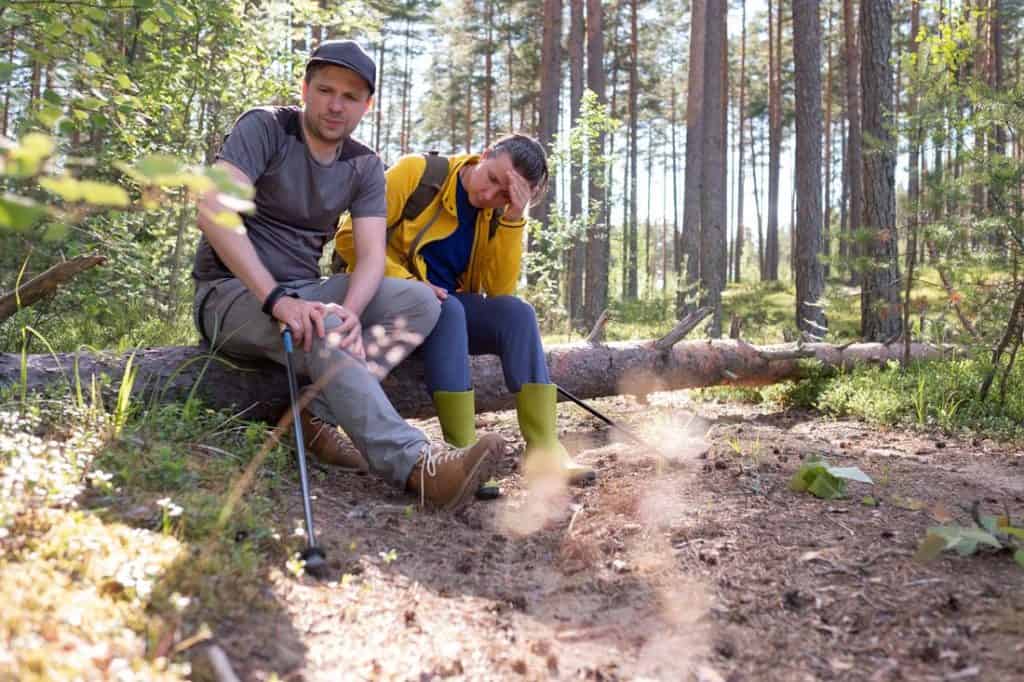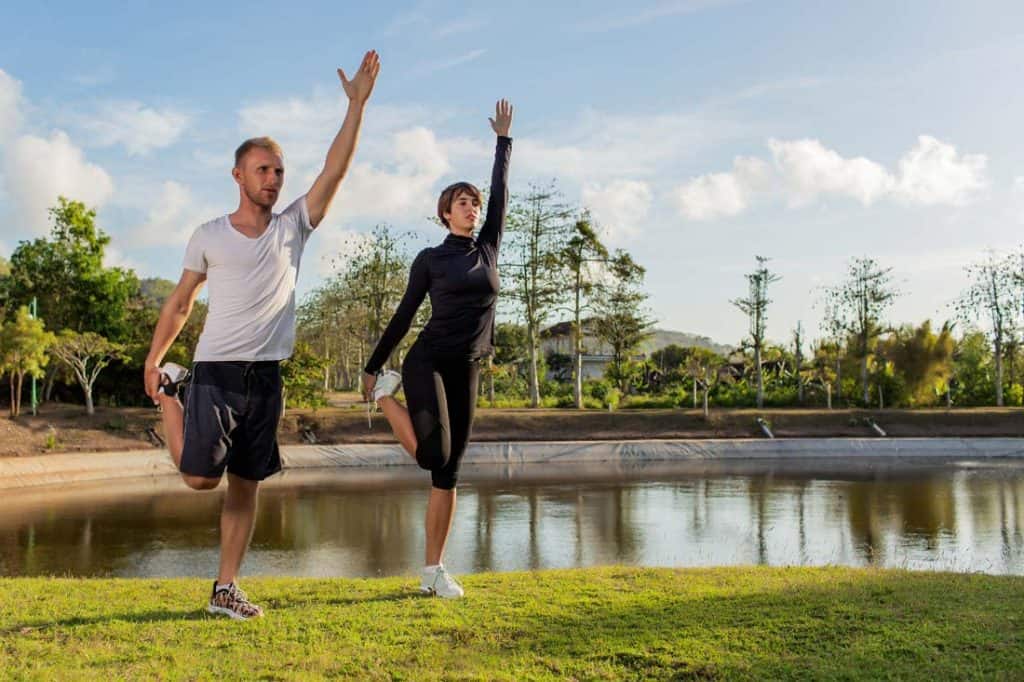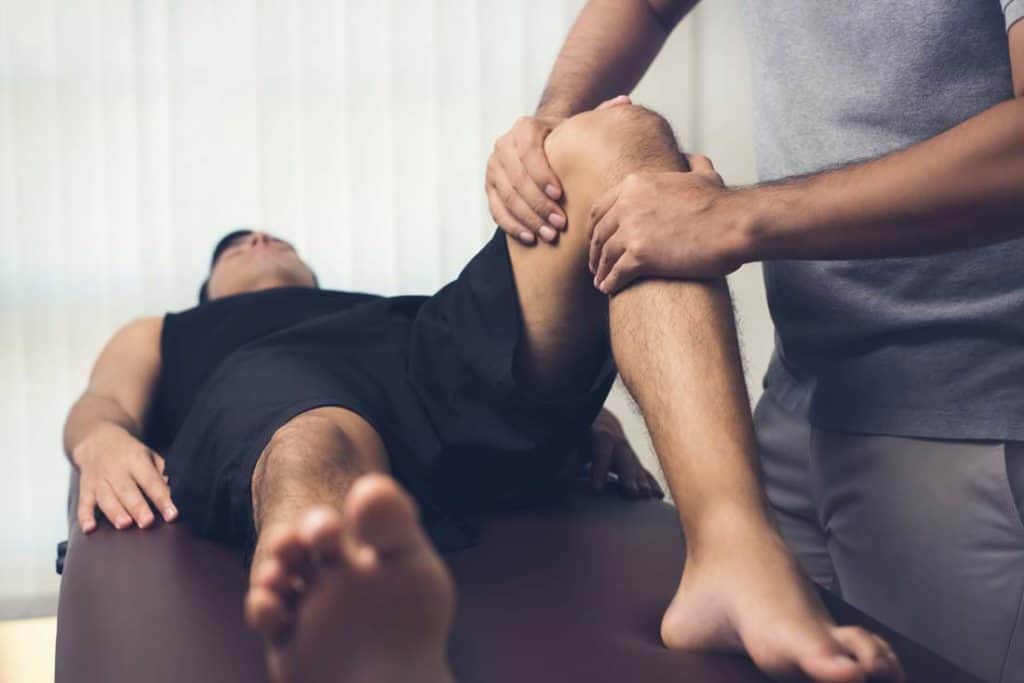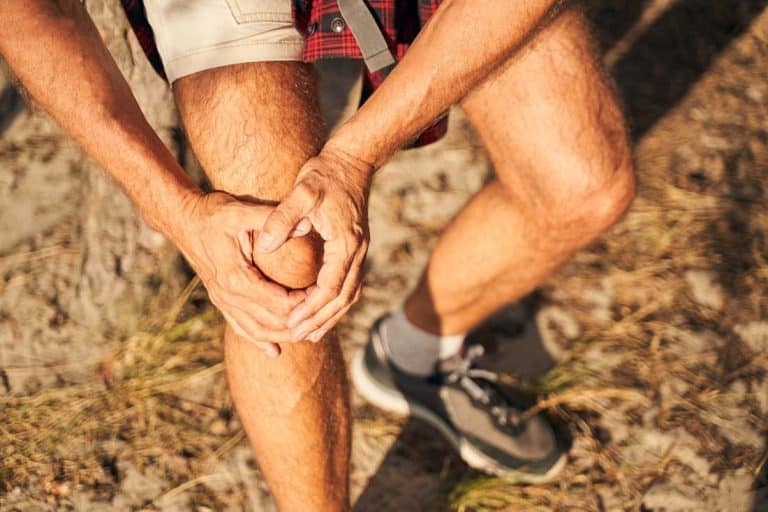For all hikers like you and us, there is a time when you will encounter the common body pains we all “acquire.” The knee pain after hiking is one of them, and the reasons behind that pain are several.
Knee pain during hiking can be the outcome of existing joint or bones or muscular conditions, or it may pop after taking the fatigue a little too far.
In this article, we will examine that type of knee pain (back or front knee), and we will explain several reasons it happens, along with ways to prevent knee pain and how to treat it.
If you haven’t read it, go and read our article on after-hike recovery.
Why Do I Have Knee Pain After Hiking?
First of all, allow us to tell you that this is one of the most common pains after or during hiking. The knees (and any joint) are stressed during hiking, either walking in plain trails or going uphill and downhill.
Knee pain usually makes its appearance around or behind the knee cap. The area becomes stiff, and walking can be from annoying to painful. Imagine that any moveable joint from your lower body takes all the weight of your body, even from standing up. The same pain is valid for your ankles. Knees get even stressed when going downhill. As research proves, the amount of stress is around eight times your body weight.
Depending on the pain location, the pain can mean fatigue or a strain, or some tearing. Consequently, the recovery measures you need to take vary from resting to a possible operation or physiotherapy.
Keep in mind that our knees are stressed during all kinds of activities in a day and not just from hiking.
What Causes Knee Pain After Hiking?

It is imperative to find the actual cause that results in knee pain. That will drive you to seek your doctor’s best advice and cure. The most common reasons for knee pain after hiking are the following. As you read, many symptoms are shared among different types of injuries. A professional will tell you what your case is.
Bursitis
Feel your knee with your hands. If it feels swollen, tender, or warm, you may have bursitis. This type of pain will usually appear on the inner side of your knee, under the joint. There is a small sac filled with fluid (called a bursa), and when this is inflamed, it causes knee bursitis.
The scope of that sac is to reduce friction between the joint bones and act as a soft cushion between your knee bones, muscles, and tendons. Inflammation leads to pain. Bursitis can occur after strenuous activities or when you frequently kneel. The same result can happen when you take a hit on your knee.
Knee tendinitis
Are you feeling a sharp pain along with tenderness below your kneecap? That can be tendinitis, and it can come with swelling and a feeling of extreme heat (burning) in the same area.
It is caused by extreme stress on the tendons, connecting bones with muscles. With continuous pressure, minor tears happen on the tendon. The latter becomes weaker and inflamed and causes that shooting pain.
Tendinosis
Another knee pain that is caused by overuse and knee stress is tendinosis. You may not notice any swelling, burning, or color change on the area (i.e., redness).
There is usually no inflammation, but your knees can become stiff, blocking you from a good range of movement, and pain is involved. It is something familiar among older people or with cases of arthritis.
Meniscus Tear
That can happen when you suddenly twist your knees while putting lots of weight on them. It can happen to flat trails or uphill, but it is common when going downhill. That is one reason why going down a hill is considered far more strenuous than going up.
When you go downhill, every step puts lots of stress on the knees, and sudden changes in the knee angle will cause some discomfort or damage. That stress is multiplied when you carry a heavy load (i.e., a backpack).
With meniscus tear, you deal with tearing of menisci, which exists between your shin and thigh bone. When tearing happens, you will feel a very sharp pain and stiffness, especially when you try to walk and twist your knee.
ACL damage
Anterior cruciate ligament keen damage can occur when there is lots of stress due to a sudden direction change, even stopping. It can be a tear or a “simple” sprain. However, you may notice swelling, a significant amount of pain, and not being able to move freely, along with a “pop” sound or feeling. When you try to walk and feel like not balancing well, that is also a possible sign of ACL damage.
Synovial Plica Syndrome
Your knee joints have a tissue that surrounds them. That is the plica. Around that, there is a membrane filled with a fluid called synovial.
When plica gets inflamed, you will feel it in the middle of your kneecap, especially when you try to bend or walk uphill or use stairs. The pain is usually not sharp but follows a curve with a peak, and the inflamed point feels swollen.
Iliotibial Band Syndrome
That “band” is a tissue that connects your hip area down to the back of your knee. The -also called as- IT band syndrome comes with swelling and inflammation, while you feel the pain spreading from the outer part of your knee to the top of the hip.
It is also a product of overuse, and when you keep hiking, the pain gets more substantial.
Patellofemoral Pain Syndrome
That is most commonly known as the “runner’s knee” and is located in the kneecap or the front of your knee joint. The pain is not that shart but usually dull. However, when you stress your knees with extra uphill or downhill walking and kneeling for long, it can worsen.
Knee Osteoarthritis
People get older, and increased stress on the knees can result in osteoarthritis, typical for all body joints, but knees suffer the most.
The protective cushion and fluids that don’t allow or reduce friction between bones degenerate, and thus it is gradually reduced. Osteoarthritis may lead to natural bones friction and chronic pain, depending on the case.
How To Prevent Knee Pain After Hiking?

Let’s find out what you can do to prevent having pain in your knees after hiking or during. The things that greatly influence the stress on your knees are correct posture, the weight you carry, preparation, clothing, and proper shoes for hiking, depending on your foot type. For example, there are special hiking boots for people with wide feet.
In a few words, everything you do and wear influences your performance and your knee’s health.
Choose Supportive Footwear
Make sure you wear proper hiking boots to move freely while supporting your foot up to the ankle. Tall hiking boots are essential for hiking, even for flat trails. If you choose to wear hiking shoes instead of boots, do wear hiking-specific shoes and not just any sports or running shoes.
Your footwear must allow for an extensive range of movement without making you stumble. They need excellent absorption properties to take most of the stress from when you put your foot down. Such pressure can happen on rocky flat terrains, going downhill or uphill.
Keep in mind that even downhill stress varies depending on the terrain and angle. You may seek and test extra hiking insoles for extra cushioning.
Stretch Before You Hit the Trails
The one thing most people neglect is to stretch before starting their hiking trail. Hiking is an exercise, and as such, it requires the proper warm-up, especially if you drove for a couple of hours to get to your entry point.
You may learn numerous stretching exercises in school or on youtube, from simple arms rotation to flexing calf muscles to left and right torso flex.
Stretching prepares your muscles and joints for strenuous activity. Try to always start from flat terrains and not go directly uphill. Muscles contract when you are sitting, so stretching is much more necessary.
Reduce the Weight of Your Gear
Make sure you carry only the items you need and not more. When you have to choose, always go for lightweight gear or ultralight.
For a day hike, choose a light hiking daypack and skip the suitable pro backpack for mountaineering.
Invest in Support Garments
It helps to wear a knee band that helps keep your knees in place, but without abusively forcing them to be like that. Kinesiology tapes help too.
Make sure you don’t put items in your trousers/pants side pockets, i.e., smartphones, wallets, etc. As you walk, they will gradually limit your movement range.
Do not wear tight non-elastic hiking pants. Tight clothing puts lots of stress on your knees when you try to move up or downhill. Hiking leggings are also another great solution.
Get a Hiking Pole
When you use them properly, hiking poles reduce stress from your legs and your overall torso movement. The pressure is transferred to your hands and shoulders.
They are most valuable when going downhill. Adjust their height depending on the ascending or descending angle for best performance and knee protection.
Take Your Time
A steady pace is more important than speed. Having a pace where you perform best will largely reduce the risk for fatigue and accidents or strains.
The critical point for hiking is to enjoy what you do and be safe.
How To Treat Knee Pain After Hiking?

There are cases where you did all the right things, yet you encountered knee pain. Let’s see some of the ways you can use to recover. Unless there are apparent symptoms like swelling, acute pain, etc., simply resting helps a lot, or a “Scotch shower” (showering alternating between warm and cold water). It depends, as plain muscle fatigue is one thing, but an injury is another.
At-home remedies
A general saying goes cold for muscles, heat for bones. However, that is not entirely correct. Depending on the case, cold may be applied first and heat later, while in some cases, an alternation between cold and heat is needed.
Here is a very detailed article on the subject and the R.I.C.E treatment model (from Sports Medicine Oregon) that provides lots of information on this particular topic. R.I.C.E stands for:
- Rise
- Ice
- Compression
- Elevate
Physical Therapy
You may need to address a physical therapist. They will examine and diagnose your case and do or propose the appropriate remedy to fix your knee pain.
Medications
Pain-relief medication and anti-inflammatory ones can help ease pain, but that is to allow you to perform until you manage to seek professional medical assistance.
Knee Injections
That is another way to get pain-relievers and anti-inflammatory medication. That is a drastic but necessary method for some patients a doctor may prescribe. It depends on the person and the case.
Surgery
If your case is so severe that it demands surgery, that is a decision a doctor must make. It is not the best you can hear, but you will have to do it if it must be done.
Disclaimer: This article provides information with the sole purpose of informing readers about the topic. It is not a replacement for professional or medical advice someone may need per their case.
Also read Why Do Hands Swell When Hiking?
